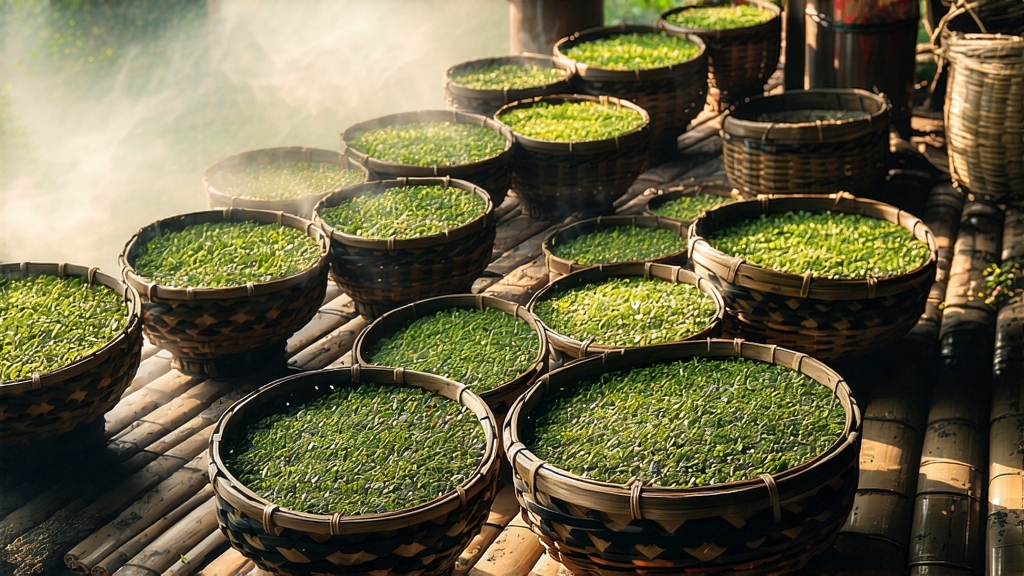
Long before Assam, Ceylon, or Earl Grey entered the Western lexicon, the cliffs of northern Fujian echoed with the crackle of pine torches and the rustle of tea leaves. There, in the Wuyi Mountains, Lapsang Souchong was born—an audacious, smoke-kissed black tea that would sail across oceans and shape the taste of the entire tea-drinking world. To understand this singular leaf is to trace the very DNA of black tea itself.
-
A history written in smoke and silver
Local legend dates the birth of Lapsang Souchong to the late Ming dynasty (circa 1640). A passing army requisitioned the drying sheds of Xingcun village; anxious farmers, eager to save their freshly picked leaves, rushed the withering over open pinewood fires. The accidental smoke infusion proved irresistible to Dutch traders at the port of Batavia, who carried the tea to Europe where it was christened “Bohea,” a corruption of “Wuyi.” By the early Qing, Lapsang Souchong had become the first black tea ever exported from China, predating Keemun by almost two centuries and establishing the very category we now call “black tea” (hong cha, literally “red tea” in Chinese). -
Terroir: where basalt meets mist
Authentic Lapsang Souchong originates within the 60 km² core scenic zone of the Wuyi UNESCO World Heritage site. Here, narrow gorges trap humid maritime air against cliffs of weathered volcanic tuff; the soil is mineral-rich, well-drained, and slightly acidic. Tea gardens sit between 600–1,200 m, shrouded in fog that filters sunlight into a soft, diffused glow. These conditions force the small-leaf tea bushes (predominantly the Wuyi qizhong or “strange cultivar”) to grow slowly, concentrating sugars, amino acids, and aromatic oils that will later marry with pine smoke. -
Two families, one leaf
Western markets often conflate all smoked teas under the label “Lapsang,” yet connoisseurs distinguish two distinct styles:
• Traditional Pinewood Lapsang (Zhengshan Xiaozhong): produced only in Tongmu Guan and protected by geographical indication, smoked with the resinous heartwood of local Masson pine and Chinese red pine. The leaf is withered, rolled, oxidized, then gently dried over dying embers in multi-tiered bamboo sheds. The smoke is cool, fragrant, and penetrating, never acrid.
• Modern “Fruit-Smoke” or Unsmoked Variants: developed for contemporary palates sensitive to assertive aromas. These versions skip the final smoking stage, yielding a malt-forward liquor reminiscent of dried longan and cocoa. Both styles share the same cultivar and mountain origin, but diverge in the last, decisive hours of production. -
Craft: the choreography of fire and time
Harvest occurs in late April, when two leaves and a bud reach the “small-leaf souchong” standard—no longer than 2.5 cm. After a brief solar withering, leaves are moved onto bamboo trays suspended above shallow trenches of smoldering pinewood. Masters regulate oxygen intake by feel, maintaining a temperature of 28–32 °C for 8–10 hours; too hot and the leaf chars, too cool and the smoke merely perfumes the surface. Once the leaf turns a deep mahogany and exudes a sweet resinous aroma, it is rolled under low pressure to preserve tip integrity, then oxidized for 3–4 hours in cedar-lined chests. The final smoking—called “la xun”—uses 40-year-old pine roots that have been buried in wet earth for six months to mellow their pitch. The roots burn so slowly that only a whisper of smoke rises, yet this stage can last two full days, during which the tea absorbs phenols, guaiacol, and syringol—the molecules responsible for its signature whisky-like nose. -
Leaf geometry and grade codes
Unlike Indian teas graded by size alone, Lapsang Souchong is classified by leaf posture and tip content:
– Pekoe Tip (P): >95 % buds, unsmoked, silvery down visible.
– Souchong (S): the classic broken-leaf grade, evenly smoked.
– Broken Souchong (BOP): smaller particles destined for Russian samovars, yielding a brisker cup.
The highest grade, “Wild Old